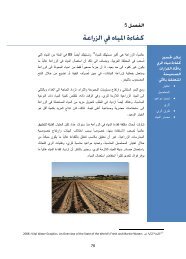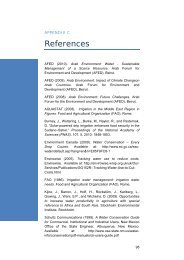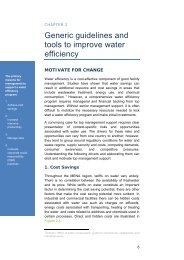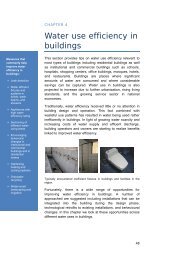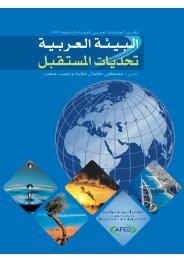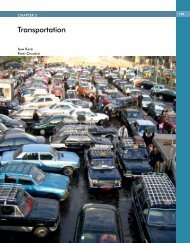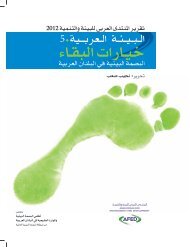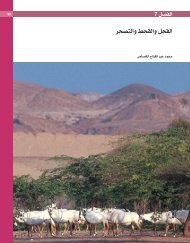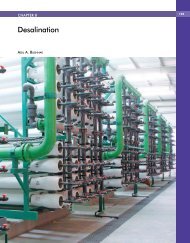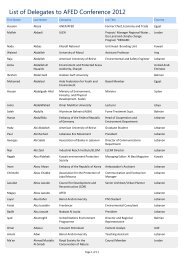Impact of Climate Change on Arab Countries - (IPCC) - Working ...
Impact of Climate Change on Arab Countries - (IPCC) - Working ...
Impact of Climate Change on Arab Countries - (IPCC) - Working ...
You also want an ePaper? Increase the reach of your titles
YUMPU automatically turns print PDFs into web optimized ePapers that Google loves.
ARAB ENVIRONMENT: CLIMATE CHANGE 125<br />
Water resources<br />
North Africa and the Middle East are almost universally<br />
recognized as the driest and least endowed<br />
with water resources regi<strong>on</strong>s <str<strong>on</strong>g>of</str<strong>on</strong>g> the world<br />
(C<strong>on</strong>stantino, 2009). This situati<strong>on</strong> c<strong>on</strong>sequently<br />
affects the ec<strong>on</strong>omic and social development <str<strong>on</strong>g>of</str<strong>on</strong>g><br />
the majority <str<strong>on</strong>g>of</str<strong>on</strong>g> the countries <str<strong>on</strong>g>of</str<strong>on</strong>g> this regi<strong>on</strong>. The<br />
average availability <str<strong>on</strong>g>of</str<strong>on</strong>g> water per capita approaches<br />
7,000 m 3 annually per capita at the global level,<br />
whereas it is less than 1,000 m 3 annually per capita<br />
in this regi<strong>on</strong> (El Naggar, 2007).<br />
The expected potential evoluti<strong>on</strong> <str<strong>on</strong>g>of</str<strong>on</strong>g> the climate<br />
would have a significant impact <strong>on</strong> both the<br />
demand and supply sides <str<strong>on</strong>g>of</str<strong>on</strong>g> water.<br />
The aggregated c<strong>on</strong>sumpti<strong>on</strong> <str<strong>on</strong>g>of</str<strong>on</strong>g> water for the<br />
tourism sector is not precisely known, but it is<br />
well recognized that the per capita c<strong>on</strong>sumpti<strong>on</strong><br />
<str<strong>on</strong>g>of</str<strong>on</strong>g> water <str<strong>on</strong>g>of</str<strong>on</strong>g> a normal tourist is higher than that <str<strong>on</strong>g>of</str<strong>on</strong>g><br />
a permanent resident. The tourism sector is <strong>on</strong>e<br />
<str<strong>on</strong>g>of</str<strong>on</strong>g> the most demanding for water c<strong>on</strong>sumpti<strong>on</strong>,<br />
either for drinking and sanitati<strong>on</strong> or for sustaining<br />
other services such as swimming pools, golf<br />
courses, and green spaces. This c<strong>on</strong>sumpti<strong>on</strong><br />
varies according to the type <str<strong>on</strong>g>of</str<strong>on</strong>g> tourism activities<br />
and the level <str<strong>on</strong>g>of</str<strong>on</strong>g> comfort demanded.<br />
The way in which this sector could be c<strong>on</strong>strained<br />
and impacted by the regressive evoluti<strong>on</strong><br />
<str<strong>on</strong>g>of</str<strong>on</strong>g> water resources and water scarcity could be felt<br />
at different levels <str<strong>on</strong>g>of</str<strong>on</strong>g> value chain. The pressure <str<strong>on</strong>g>of</str<strong>on</strong>g><br />
tourism development <strong>on</strong> water resources can lead<br />
to c<strong>on</strong>flicts <str<strong>on</strong>g>of</str<strong>on</strong>g> uses, mainly when diverting water<br />
from agriculture which ensures food security for<br />
local dwellers to an industrialized tourism activity,<br />
which is mostly pr<str<strong>on</strong>g>of</str<strong>on</strong>g>itable to tour operators<br />
and big companies.<br />
The reducti<strong>on</strong> <str<strong>on</strong>g>of</str<strong>on</strong>g> water flows and water stocks in<br />
lakes will lead to diminishing water quality by<br />
eutrophicati<strong>on</strong> and polluti<strong>on</strong>. This situati<strong>on</strong> will<br />
induce diminishing recreati<strong>on</strong>al value and will<br />
also lead to an increasing risk <str<strong>on</strong>g>of</str<strong>on</strong>g> water-borne diseases.<br />
With temperatures changing, new viruses<br />
or microbes will have a potential for development<br />
in the new envir<strong>on</strong>ment, and this might affect<br />
the tourism flow and the ec<strong>on</strong>omic importance<br />
<str<strong>on</strong>g>of</str<strong>on</strong>g> the sector.<br />
Projecti<strong>on</strong>s based <strong>on</strong> observati<strong>on</strong>s since the<br />
beginning <str<strong>on</strong>g>of</str<strong>on</strong>g> the 20th century in the northeast <str<strong>on</strong>g>of</str<strong>on</strong>g><br />
Morocco point out a further increase <str<strong>on</strong>g>of</str<strong>on</strong>g> water<br />
scarcity due to climatic and human pressures;<br />
sustainable l<strong>on</strong>g term development seems to be a<br />
challenge, in particular with regard to water<br />
availability and coastal tourism (Tekken et al.,<br />
2009).<br />
Coastal z<strong>on</strong>es and sea level rise<br />
The speed <str<strong>on</strong>g>of</str<strong>on</strong>g> sea level rise is neither uniform in<br />
the world, nor within the <strong>Arab</strong> world.<br />
Observati<strong>on</strong>s and future projecti<strong>on</strong>s established<br />
<strong>on</strong> the basis <str<strong>on</strong>g>of</str<strong>on</strong>g> climatic models created by many<br />
researchers, including the <strong>IPCC</strong> (2007), indicate<br />
a potential increasing sea level in the<br />
Mediterranean by about 88 cm between the years<br />
1990 and 2100.<br />
Therefore, the <strong>Arab</strong> world countries located <strong>on</strong><br />
the Mediterranean coast will be str<strong>on</strong>gly threatened<br />
by sea level rise which could be accelerated<br />
by high tides and violent storms. Large coastal<br />
areas would disappear because <str<strong>on</strong>g>of</str<strong>on</strong>g> sea water<br />
immersi<strong>on</strong> and coastal erosi<strong>on</strong> (for example <str<strong>on</strong>g>of</str<strong>on</strong>g><br />
the Nile delta and all low topography z<strong>on</strong>es), and<br />
the salinity <str<strong>on</strong>g>of</str<strong>on</strong>g> coastal aquifers and rivers would<br />
increase (Fi<strong>on</strong>a, 2004).<br />
Letizia et al. (2008) have shown through a meteorological<br />
marine analysis <str<strong>on</strong>g>of</str<strong>on</strong>g> the Moroccan<br />
Mediterranean coast that the prevalent waves<br />
coming either from 270ºN or 60ºN can hit the<br />
coast at heights approaching 5m. The most<br />
threatened z<strong>on</strong>es in the area include coastal wetlands,<br />
sandy beaches, a river mouth, basic infrastructure,<br />
harbours, a leisure port, habitati<strong>on</strong>s<br />
and <strong>on</strong>e important seashore tourism resort comprising<br />
more than 27,000 beds.<br />
The vulnerability <str<strong>on</strong>g>of</str<strong>on</strong>g> the <strong>Arab</strong> world’s tourism<br />
sector is obviously related to that <str<strong>on</strong>g>of</str<strong>on</strong>g> the beaches<br />
and the infrastructure which c<strong>on</strong>stitute the basis<br />
<str<strong>on</strong>g>of</str<strong>on</strong>g> most presently promoted tourism in the area,<br />
mainly for the North African countries.<br />
Analysis <str<strong>on</strong>g>of</str<strong>on</strong>g> shoreline evoluti<strong>on</strong> <strong>on</strong> the Eastern<br />
Mediterranean coast <str<strong>on</strong>g>of</str<strong>on</strong>g> Morocco, using aerial<br />
photos, has shown that in two pilot sites, the<br />
beaches were subject during the last two decades<br />
to c<strong>on</strong>tinuous erosi<strong>on</strong> at an average rate <str<strong>on</strong>g>of</str<strong>on</strong>g> 0.5<br />
m/year (Amini et al., 2008). Each <str<strong>on</strong>g>of</str<strong>on</strong>g> the two sites<br />
c<strong>on</strong>tains a wetland <str<strong>on</strong>g>of</str<strong>on</strong>g> internati<strong>on</strong>al importance.<br />
These ecosystems are vulnerable either to beach



